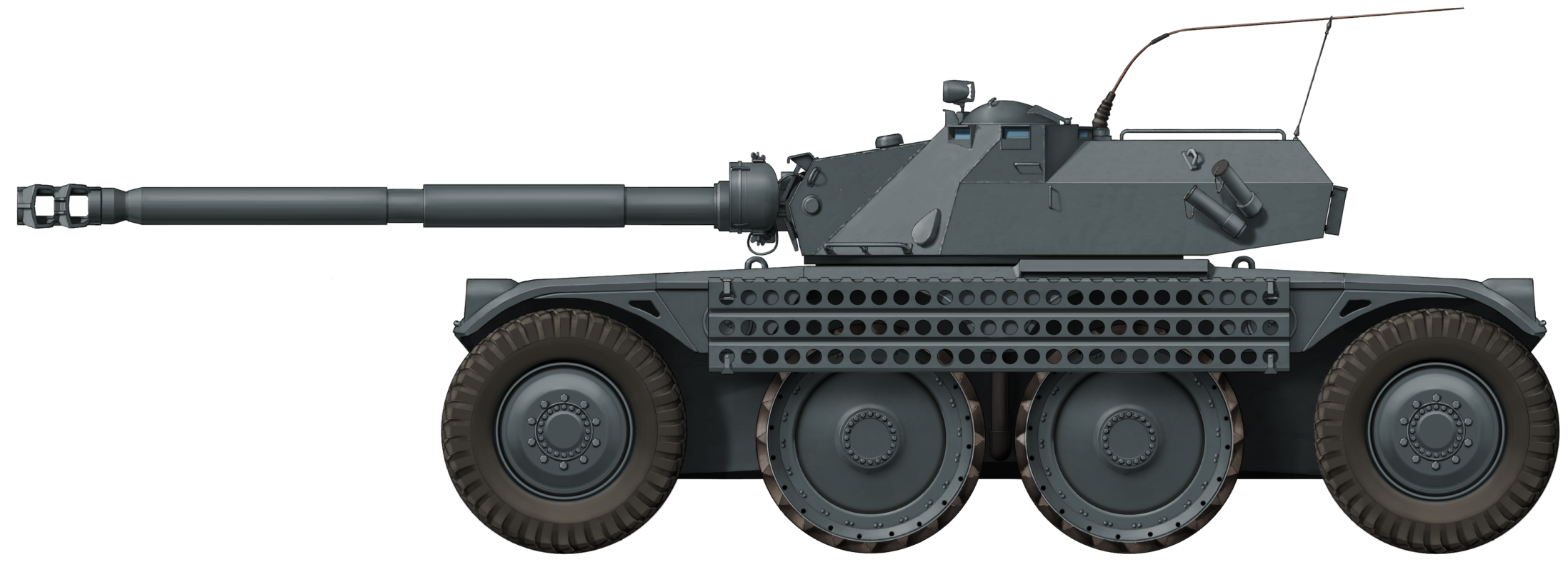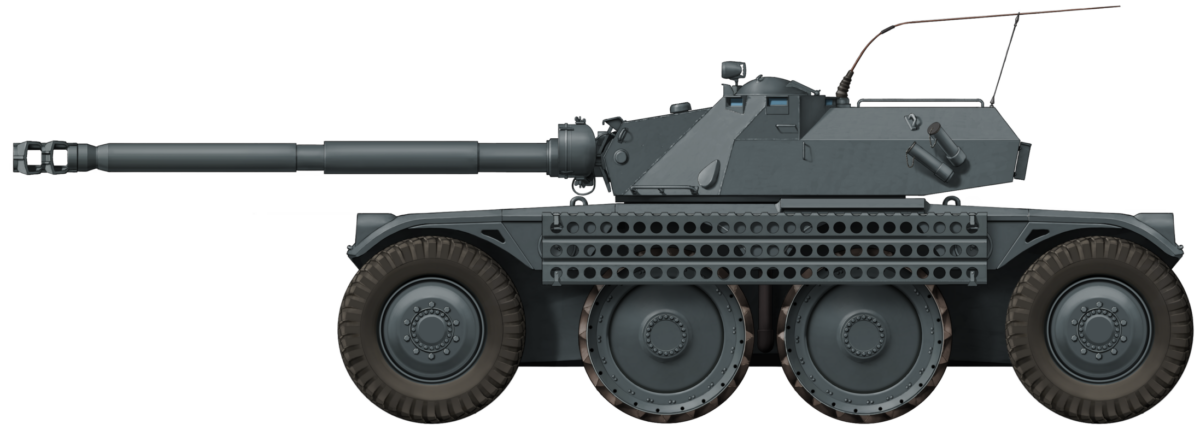
 France (1970s)
France (1970s)
Armored Car – Fake
The French company of Panhard was and remains perhaps the largest provider of wheeled armored vehicles of the French military ever since the interwar era. The manufacturer of many of France’s most successful armored cars, such as the Panhard 178 or AML, one of the company’s most peculiar armored vehicles for its time was the 8-wheeled Panhard EBR. It was developed as a response to a program initiated as early as March of 1945 by the French Military, looking for a 75 mm armed, high-mobility, long-range wheeled reconnaissance vehicle.
Panhard’s vehicle was adopted in December of 1949 and mass-produced in two major variants all the way up to 1960. Notable for its quite heavy firepower for a wheeled vehicle (particularly the model fitted with the AMX-13’s FL-10 turret, produced from 1954 onward), 8-wheel configuration with two metallic side-wheels being used to improve the vehicle’s cross-terrain capacities (the vehicle using just the 4 front and rear wheels on good terrain), and dual driving post guaranteeing equal speed forward and backward, the EBR served as a mainstay of the French military’s reconnaissance force for most of the Cold War. The vehicle was finally retired in 1985.
In comparison to many other French military vehicles of the era, the EBR was long excluded from most popular video games focusing on armored vehicles, due to those, for a time, almost exclusively including only tracked vehicles. In recent years, though, the progressive diversification of these games, and notably Wargaming’s ‘World of Tanks’ (‘WoT’), has lead to the inclusion of French wheeled vehicles in WoT’s update 1.4, on the 6th of February 2018. As part of that upgrade, six French wheeled vehicles were added to the game; of those, one was Hotchkiss’ EBR prototype, the unlucky competitor to the Panhard EBR in the late 1940s, and two variants of the Panhard EBR: the EBR 90, and the so-called ‘EBR 105’, armed with a 105 mm gun in a turret that has never been seen on the EBR. (The model 1954 EBR, fitted with the FL-10 turret, would also be added a premium at a later date)

Historical upgrades to the EBR’s firepower
Historically, the Panhard EBR went through two major upgrades to its firepower during its service.

As it first entered service, the EBR was fitted with the 75 mm SA 49 main gun; a medium-velocity 75 mm gun, offering anti-armor performances more along the lines of the 75 mm guns used in vehicles the likes of the Panzer IV during the Second World War – so quite outdated by the 1950s. This gun was fitted in the FL-11, a fairly small oscillating turret, featuring no autoloader but a manual loader instead.
The first concept for improving the EBR’s firepower was straight up giving the vehicle the FL-10 turret used on the AMX-13, which featured the longer 75 mm SA 50 with an autoloader, and was much larger and higher. This concept was first considered in 1951; an EBR prototype first received the FL-10 turret in 1952, and after an order in July of 1953, the first examples would be delivered in the last days of 1954. This model would be known as the EBR model 1954.

The 75 mm SA 50 offered much more firepower than the SA 49, but the addition of the FL-10 turret made the EBR heavier (from 12.5 to 14.9 tonnes) and higher (from 2.33 to 2.58 m). Therefore, the FL-10 armed model only supplemented the FL-11 armed one, with only about 280 FL-10 equipped EBR manufactured, while about 900 FL-11 equipped ones were produced.
The 1960s saw considerable evolution in anti-tank gun technology, and notably lower-pressure guns firing HEAT projectiles. These new guns could offer performances similar or even superior to older low-velocity guns at a fraction of the weight (albeit typically at a reduced maximum effective range). For the EBR, this resulted in the D.921A gun, the same as on Panhard’s lighter AML being adopted for the FL-11 equipped examples in 1964. With the Panhard EBR being out of production by four years at this point, 650 FL-11 equipped EBR were refitted with the 90 mm gun, and all remaining EBRs equipped with the FL-10 or FL-11 were phased out of service.

No major firepower upgrade appears to have been considered on the EBR following the refitting of the 90 mm D.921A, with the vehicle quickly appearing to be, by most measures, quite obsolete (lacking in NBC protection notably). While a replacement was considered as early as the 1960s in the form of the ERAC, its final development, the AMX-10RC, would only enter service in the late 1970s – leaving the last EBRs soldiering on until 1985 in France.
Wargaming’s EBR 105
In Wargaming’s World of Tanks, the EBR 105 stands as the pinnacle of French wheeled vehicles in the game, as a Tier X; it serves as the conclusion of the branch.
Wargaming’s description of the vehicle is as follows: “A variant of the Panhard EBR armored vehicle with more powerful armament. It featured improved suspension and the two-man GIAT TS 90 turret, upgraded to accommodate a 105 mm gun. The vehicle never saw mass production, nor entered service.”
Nothing is mentioned in the way of dates, however, a quick examination of the vehicle would show the vehicle would at least be a late 1970s development, due to its turret being first mounted on an armored vehicle in 1977.
The inaccurately-modeled TS 90 turret
The turret mounted on the EBR 105 is a modified version of the NEXTER TS 90 turret, mounted on the old hull of the EBR.
Introduced by Nexter in 1977, this is a welded two-man turret with a manually loaded 90 mm anti-tank gun in its historical configuration. This fairly light turret (2.5 tonnes with ammunition but without crew) could theoretically be mounted on any vehicle that could accommodate a sufficiently large turret ring as well as weigh at least 7.5 tonnes. In practice, however, it is mounted on the ERC-90 for the French army and export, VBC-90 for the French gendarmerie and Oman, and on the AMX-10 tracked chassis, creating the AMX-10P PAC 90 for export. A variety of other vehicles, such as the Mowag Piranha or even the M113 were modified to mount the turret but never went beyond the prototype stage with it.

However, Wargaming did not straight up take the historical TS 90 turret and mount it on the EBR. This would already be an unhistorical combination; by the time the TS 90 was around, the EBR was on its way out, with its straight-up replacement, the AMX-10RC, beginning to enter service; the sometimes more than 25 years old hulls were worn out by years of intensive use, and there was little will or need to keep using them for long. Wargaming designed its own heavily modified version of it. It is referred to as the ‘Panhard EBR 105’ turret.
In real life, the TS 90 is a two-man turret with a manually loaded 90 mm gun. In this form, it is already quite cramped. Wargaming, however, swapped out the turret’s 90 CN-90 F4 for the older but larger 105 mm D.1504 or CN-105-57 – the 105 mm gun featured, for example, on the Israeli M51 Sherman, the AMX-13-105 or the SK-105 Kürassier. This gun is manually loaded on the EBR 105, however, it ought to be noted that another fake vehicle produced by Wargaming, the Batignolles-Châtillons “Bourrasque” which uses the same modified TS 90 turret, is fed by a two-rounds autoloader.
Wargaming’s 105 mm-armed version of the TS 90 is visibly extended towards the rear, most likely in order to simulate the larger breech. Unlike on the Bourrasque, in which the presence of both an autoloader and the larger breech would likely make the turret extremely cramped, the EBR’s version of the modified TS 90 may be somewhat plausible in terms of internal space; however, this turret having a two-man crew means the commander would also assume the role of loader, for the fairly large 105 mm rounds used by the CN-105-57 – making his task more complex and harder to perform. Historically, there are no known projects aiming to mount a 105 mm gun in the TS 90 turret. Light vehicles contemporary with its development (though they would have to be somewhat heavier to mount such a turret) typically used the TK 105 three-man turret featured in the AMX-10RC. This turret mounts a more modern 105 mm MECA F2 L/48 low-pressure gun, a far more modern gun than the CN-105-57 featured on the fictional EBR 105.

Weight increase and mysteriously improved engine
Wargaming’s EBR 105 is stated to have a weight of 17 tonnes – whether the vehicle would actually feature such a weight with Wargaming’s fictional version of the TS90 turret is not known. This is, however, a considerable addition of weight onto the EBR, weighing slightly more than 2 tonnes more than the FL-10 equipped model 1954 EBR, and 4.5 tonnes more than the original, FL-11 equipped production model. While Wargaming does mention the vehicle as having a reinforced suspension in its short description, the EBR’s capacity to reasonably operate at such a weight is unknown.
What is almost certainly unimaginable though is that the vehicle received the tremendous upgrade in powerplant Wargaming gave the EBR 105. Historically, all models of the EBR used the Panhard 12H 6000S engine. This 12-cylinder air-cooled engine could produce up to 200 hp at 3,700 rpm, which was sufficient to give the EBR a quite admirable maximum speed for the time. The model 1951 FL-11 equipped model could peak at 105 km/h on a good road, and despite receiving no power plant upgrade, the heavier FL-10 equipped model 1954 was reported to be able to reach this speed as well.
The engine used in Wargaming’s EBR 105 appears to be a development of the original Panhard engine used in the EBR – being referred to as the ‘Panhard 12H 6000 X’, but it has been boosted to an implausible 720 hp. It is unlikely such a powerful engine could be derived from the 12H engine to begin with and combined with the idea that it may be fitted in an EBR hull is stretching the bounds of plausibility to the limit, seeing as this likely would result in a much larger power plant.
Wargaming’s EBR 105 did receive some notable changes to its design. Notably, the rear no longer features any form of driving post, but instead what appears more along the line of an engine compartment, which raises the question of where the vehicle’s fourth crew member, which Wargaming refers to as a ‘radio operator’, would be located. However, the idea that this hull change would be enough to fit such a powerful and likely larger engine is very unlikely (and in any case, nothing suggests the increased size of a largely boosted up version of the EBR’s engine was taken into account when designing the vehicle). This engine gives Wargaming’s vehicle a power-to-weight ratio of 42.35 hp/ton, far higher than the EBR model 1951’s mere 16 hp/ton. However, despite this, Wargaming’s EBR 105 is still appreciably slower than all other EBRs, at ‘merely’ 91 km/h. In general, all that surrounds its automotive capacities and upgrades can be described as quite nonsensical.


Conclusion – Another kitbashed fake tank
The EBR 105 that Wargaming introduced into World of Tanks is obviously a fake vehicle. While it may take inspiration in the fact the EBR was mass-produced with two different turrets and received considerable firepower upgrades during its service life, this does not change the fact that, as it is presented, the vehicle makes little sense. The use of components such as the TS 90 turret would suggest the EBR 105 would have been a late 1970s project, and by that time, the far superior AMX-10RC would have been on its way to replace the EBR – 105 mm-armed or not. This is particularly underlined by the fact a vehicle such as the EBR 105 would have been very close to a complete rebuild; with a new engine, new turret, new hull rear, and reinforced suspension, there would, in the end, be little but the mere shell of the original EBR left, a most likely very costly upgrade.
The EBR 105 is far from the only fake tanks featured in World of Tanks; another French fake vehicle, the ‘Batignolles-Châtillon Bourrasque’, is quite closely linked to it, being a kitbash of the modified TS 90 turret modeled for the EBR 105 and the hull of the BatChat 12t light tank. It can be argued to be somehow even more nonsensical than the EBR 105, combining a modified version of a turret produced from the late 70s onward with a hull on which no developments are known after 1951. In general, WoT, particularly its higher tiers, contains a quantity of fake vehicles: one could, for example, cite most Chinese tank destroyers, or the FV215b, Conqueror Gun Carriage, and Caervanon Action X. As for unhistorical configurations of vehicles that did actually exist, those are legion, though some are more shocking than others; within French vehicles, the famous AMX-40 stands as a notable example.


EBR 105 specifications |
|
| Total weight, battle-ready | 17 tonnes |
| Engine | 720 hp ‘Panhard 12H 6000 X’ |
| Power-to-weight ratio in hp/tonne | 42.35 |
| Top road speed | 91 km/h |
| Turning angle | 33° |
| Main armament | 1 x 105 mm D.1504/CN-105-57 main gun (36 rounds) |
| Rate of fire | 5 rounds per minute |
| Secondary Armament | None featured in WoT specifications but possibly the same 7.62 mm AANF1 as on the standard TS90 turret |
| Turret traverse speed | 66 deg/s |
| Hull Armor | 40 mm (front & rear), 16 mm (sides), 20 mm (bottom), 10 mm (roof) |
| Turret Armor | 15 mm (front & mantlet), 10 mm (sides & rear), 8 mm (top) |
| Total production | None |
Sources:
Char-français:
http://www.chars-francais.net/2015/index.php/engins-blindes/blindes-a-roues?task=view&id=710
http://www.chars-francais.net/2015/index.php/engins-blindes/blindes-a-roues?task=view&id=708
http://www.chars-francais.net/2015/index.php/engins-blindes/blindes-a-roues?task=view&id=41
http://www.chars-francais.net/2015/index.php/engins-blindes/blindes-a-roues?task=view&id=782
http://www.chars-francais.net/2015/index.php/engins-blindes/blindes-a-roues?task=view&id=726
Army-guide
AMX30 Main Battle Tank Enthusiast’s Manual, Haynes editions, M.P Robinson & Thomas Seignon, 2020


5 replies on “Panhard EBR 105 (Fake Tank)”
What a beautiful article!
I somehow actually likes this because this is the only EBR Variant except for the troop carrier that doesn’t have an oscillating turret.
walter ):
I find it so sad that in while Wargaming has found something pretty awesome in bringing out blueprint only designs, they continue to disregard some of the more realistic and workable solutions in favor of something completely fake. The tier X should have been some form of the AMX-10.
In March, 1963, the 105mm D.1090 from the ERAC program was atleast briefly considered for mounting on the EBR chassis in either the FL-10 or FL-11 turret.